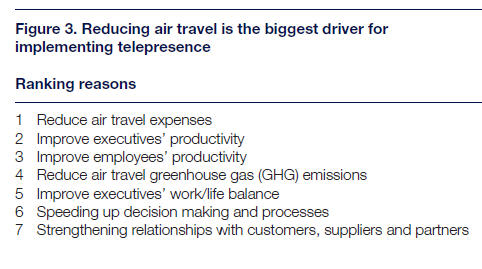Telepresence: The CO2 emission, ROI case

Telepresence can cut 5.5 metric tons of CO2 emissions through 2020 if U.S. and U.K. companies substitute travel for telepresence, according to a study.
The study was commissioned by the Carbon Disclosure Project by AT&T.
Although the findings aren't all that surprising, there are a few interesting data nuggets. For instance, 5.5 metric tons of CO2 emissions are the equivalent of removing on million passenger vehicles from the road for a year. The total benefits to the economy would be about $19 billion by 2020.
AT&T's study, produced by research firm Verdantix, looked at businesses with $1 billion or more in annual revenue. If these companies implemented four telepresence rooms they could garner a return on investment in 15 months, save nearly 900 business trips in the first year and cut emissions by 2,271 metric tons over 5 years. Those figures are based on interviews with 15 companies such as Accenture, EMC and Microsoft that have adopted telepresence.
A few notable factoids from the study:
- 60 percent of telepresence usage is attributed to executives in the first year. After that usage broadens to more employees.
- Critical mass for telepresence usage can be as little as 25 employees if those workers travel a lot. Eliminating long-haul trips can boost returns. Some industries where workers don't travel as much---think consumer product manufacturers---need an office of about 500 employees to justify telepresence.
- Travel is the biggest reason for telepresence implementations.
- Details like simplicity, privacy and security boost adoption.
- The study assumes upfront investment costs for high-end telepresence costs to be $200,000 per room and $400,000 for installation, set-up and testing. Ongoing operating costs for bandwidth are $50,000 with electric and technical support running you another $35,000 a year. The travel case goes like this:
- Retail will be the industry with the most telepresence installations by 2020. Given all the sourcing in Asia, this projection makes sense.
